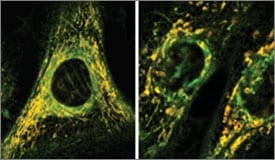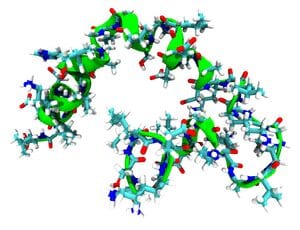
New insights into how antibiotics damage human cells suggest novel strategies for making long-term antibiotic use safer
A team of scientists at the Wyss Institute for Biologically Inspired Engineering at Harvard University has discovered why long-term treatment with many common antibiotics can cause harmful side effects — and they have uncovered two easy strategies that could help prevent these dangerous responses. They reported the results in the July 3rd issue of Science Translational Medicine.
“Clinical levels of antibiotics can cause oxidative stress that can lead to damage to DNA, proteins and lipids in human cells, but this effect can be alleviated by antioxidants,” said Jim Collins, Ph.D., who led the study. Collins, a pioneer of synthetic biology and Core Faculty member at the Wyss Institute, is also the William F. Warren Distinguished Professor at Boston University, where he leads the Center of Synthetic Biology.
Doctors often prescribe antibiotics freely, thinking that they harm bacteria while leaving human tissue unscathed. But over the years reports have piled up about the occasional side effects of various antibiotics, including tendonitis, inner-ear problems and hearing loss, diarrhea, impaired kidney function, and other problems.
Collins suspected these side effects occurred when antibiotics triggered oxidative stress — a condition in which cells produce chemically reactive oxygen molecules that damage the bacteria’s DNA and enzymes, as well as the membrane that encloses the cell.
Collins’ team had already discovered that antibiotics that kill bacteria do so by triggering oxidative stress in the bacteria. They wondered whether antibiotics caused side effects by triggering oxidative stress in the mitochondria, a bacterium-like organelle that supplies human cells with energy.
Sameer Kalghatgi, Ph.D., a former postdoctoral fellow in Collins’ laboratory who is now Senior Plasma Scientist at EP Technologies in Akron, Ohio, and Catherine S. Spina, a M.D./Ph.D. candidate at Boston University and researcher at the Wyss Institute, first tested whether clinical levels of three antibiotics — ciprofloxacin, ampicillin, kanamycin — each cause oxidative stress in cultured human cells. They found that all of these drugs were safe after six hours of treatment, but longer-term treatment of about four days caused the mitochondria to malfunction.
Kalghatgi and Spina then did a series of biochemical tests, which showed that the same three antibiotics damaged the DNA, proteins and lipids of cultured human cells — exactly what one would expect from oxidative stress.
The results mean that “doctors should only prescribe antibiotics when they’re called for, and patients should only ask for antibiotics when they have a serious bacterial infection,” Collins said.
The team also treated mice with the same three antibiotics in mouse-sized doses similar to what patients receive in the clinic. Long-term treatment with each of the three antibiotics damaged the animal’s lipids and caused levels of glutathione, one of the body’s natural antioxidants, to fall — another sign of oxidative stress.
To make a difference in the clinic, however, the scientists still needed a way to prevent antibiotic-induced oxidative stress — or a way to remediate it as it was occurring. They found both. They were able to prevent oxidative stress by using a bacteriostatic antibiotic — an antibiotic such as tetracycline that stops bacteria from multiplying but does not kill them. They could also ease oxidative stress by mopping up chemically reactive oxygen molecules with an FDA-approved antioxidant called N-acetylcysteine, or NAC, that’s already used to help treat children with cystic fibrosis.
The Latest Bing News on:
Antibiotic side effects
- At least 25,000 people in the US are starting weight-loss drug Wegovy each week, drugmaker sayson May 2, 2024 at 8:49 am
Drugmaker Novo Nordisk said it’s been increasing supply of its sought-after weight-loss drug Wegovy, with at least 25,000 people now starting to take the medicine each week in the United States.
- Men taking common hair loss drug ‘loved by Donald Trump’ warned of ‘psychiatric and sexual’ side effectson May 1, 2024 at 6:48 am
MEN who take the hair loss drug finasteride are being warned of psychiatric and sexual side effects. The medicine — taken by Donald Trump — can cause depression, suicidal thoughts, decreased sex ...
- Expert warns of 'weight loss' drug Ozempic's side effects after losing three stoneon May 1, 2024 at 4:14 am
Ozempic is a drug primarily prescribed to diabetic people, however it is commonly used as an off-label drug for weight loss ...
- FDA Approves New Antibiotic for Uncomplicated Urinary Tract Infectionson April 30, 2024 at 11:30 pm
The U.S. Food and Drug Administration has approved Pivya (pivmecillinam) tablets for the treatment of female adults with uncomplicated urinary tract infections (UTIs). The approval is for UTIs caused ...
- Does Finasteride Cause Side Effects? Doctors Explain.on April 30, 2024 at 1:48 pm
Doctors say the hair loss treatment is safe and effective but might not be the best option for everyone. Always talk to your doctor if you have side effects.
- Page settingson April 30, 2024 at 6:18 am
Moxifloxacin is used to treat a variety of bacterial infections. Norfloxacin, sold under the brand name Noroxin among others, is an antibiotic that belongs to the class of fluoroquinolone antibiotics.
- Food Network star Sandra Lee reveals weight-loss drug side effects left her ‘sick as sick could be’on April 29, 2024 at 2:02 pm
Food Network star Sandra Lee spoke with Fox News Digital about trying a weight-loss drug that left her bed ridden for a week and why she’s not a fan.
- Hair-loss and enlarged prostate drug carries risk of serious side effectson April 29, 2024 at 12:01 pm
Men on a popular hair-loss drug have been warned of its potential serious sexual and psychiatric side effects by the drug regulator. The Medicines and Healthcare products Regulatory Agency (MHRA) said ...
- Men on hair-loss drug warned of sexual and psychiatric side effectson April 29, 2024 at 12:01 pm
Men on a popular hair-loss drug have been warned of its potential serious sexual and psychiatric side effects by the drug regulator.
- Dear Doctor: Why didn't anyone warn me about the painful side effects from taking Levofloxacin?on April 29, 2024 at 5:55 am
The Food and Drug Administration put a "black box" warning (the highest possible warning) on levofloxacin to remind physicians of the danger.
The Latest Google Headlines on:
Antibiotic side effects
[google_news title=”” keyword=”antibiotic side effects” num_posts=”10″ blurb_length=”0″ show_thumb=”left”]
The Latest Bing News on:
Oxidative stress
- Top 7 Health Benefits Of Mangoon May 2, 2024 at 8:52 am
Mangoes are rich in vitamin A and beta-carotene, which promote good vision and may reduce the risk of age-related macular degeneration. The antioxidants in mangoes, such as vitamin C and beta-carotene ...
- Mediterranean Diet And Back Pain: How Can This Unique Diet Help Alleviate Pain Among Older Adults?on May 2, 2024 at 7:39 am
Chronic pain is a result of oxidative stress in the body and inflammation. Experts from the study say that, certain dietary restrictions and changes may be transformational for patients Why? According ...
- Time-restricted eating vs. fewer calories. Study shows which works best in weight losson May 2, 2024 at 2:00 am
Time-restricted eating has been shown to have metabolic advantages including improved glucose control, reduced inflammation and reduced oxidative stress. With my clients who respond to more structure, ...
- Study: Combine intermittent fasting with high-intensity exercise to boost healthon May 1, 2024 at 11:00 am
Among inactive women with obesity, combining time-restricted eating with high-intensity exercise may lead to more transformative changes in body composition and cardiometabolic health than either ...
- The Best Ashwagandha Supplementson April 30, 2024 at 12:01 pm
Branded content. Us Weekly has affiliate partnerships so we may receive compensation for some links to products and services. No matter your age, where you live, or your occupation, stress doesn’t ...
- Less calcium at dinner, more at breakfast may help lower cardiovascular riskon April 30, 2024 at 9:00 am
New research suggests that the time of day at which a person consumes calcium may influence whether their cardiovascular risk increases or decreases.
- Cinnamon, curcumin, and resveratrol show promise in diabetes inflammation fighton April 25, 2024 at 11:18 pm
Researchers reviewed the impact of cinnamon, curcumin, and resveratrol on oxidative stress and inflammation in type 2 diabetes patients, highlighting their potential to improve metabolic regulation ...
- News tagged with oxidative stresson April 25, 2024 at 5:00 pm
Mitochondria, organelles with an inner and outer membrane, are responsible for creating the energy that cells use to survive, and their morphology is key to accomplishing this task. The inner ...
- Oxidative Stress News and Researchon April 25, 2024 at 5:00 pm
Researchers reviewed the impact of cinnamon, curcumin, and resveratrol on oxidative stress and inflammation in type 2 diabetes patients, highlighting their potential to improve metabolic ...
- Mitochondrial biology and oxidative stress in Parkinson disease pathogenesison April 9, 2024 at 5:00 pm
20 Similar pathways are also activated by opening of the mitochondrial permeability transition pore, an event that can occur under conditions of oxidative stress or electron transport chain ...
The Latest Google Headlines on:
Oxidative stress
[google_news title=”” keyword=”oxidative stress” num_posts=”10″ blurb_length=”0″ show_thumb=”left”]











